The program’s actions are conducted in partnership with the Earth Institute
Conducted in partnership with the Earth Institute, the Spring Recovery Program continues its activities with the engagement of rural property owners. In recent months, they were instructed on how to protect water courses that emerge on their land and received technical guidance and materials necessary to surround the springs. In addition, the Earth Institute offers manpower for those property owners who need support in the execution of the service.
According to the forester of the Renova Foundation, Felipe Tieppo, the operating area of soil is very degraded by farming. “The protection prevents cattle access to the springs, stimulates the natural regeneration of local species and contributes to the reduction of soil compaction, preventing the rain from taking material with it into the river bed”. The program also provides, among other measures, fire protection, planting seedlings and control of competitors like the Brachiaria grass, which competes for soil resources with local vegetation and is very common in pastures.
The completion of the recovery of the springs is scheduled for May 2018. The 500 identified springs are located in the drainage basins of the rivers Suaçuí Grande, Pancas and Santa Maria do Doce, mainly influencing the municipalities of Governador Valadares (MG), Pancas and Colatina (ES), respectively.

Protected spring at Fazenda Alto Pancas in Pancas (ES). | Photo: Release
MONITORING AND DIALOGUE
In December and January a team of Renova visited sources in the basins of the Santa Maria do Doce River and the Pancas River. The professionals monitored the activities implemented by the Earth Institute and contributed to improvements to the methodology.
The Earth Institute is an environmental institution, founded by photographer Sebastião Salgado, who has been developing the Olhos D’água Spring Program for the Doce River Valley since 2010. The initiative aims to recover and protect 300 thousand springs by 2046. Learn about other actions here.
